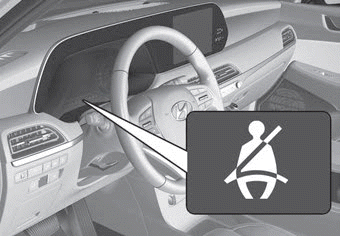Hyundai Palisade: Tire Pressure Monitoring System / TPMS Sensor
Description and operation
| Description |

| 1. |
General description
WU is a sensor placed in the tire that reports pressure and temperature.
The WU is mounted inside the wheels, fixed to the valve. The angle between
the valve and the housing of the WU is variable.
This allows adaptation to various types of rims.
The Wheel Unit is made of a PCB supporting the electronic hardware and
encapsulated inside a housing which is potted with polyurethane.
It is self-powered by a battery and includes all systems for parameter
measurement (pressure, temperature and centrifugal acceleration and
optionally rotation direction), RF transmission and LF detection.
To achieve the specified battery lifetime, the WU supports various measurement
and transmission timings, depending on WU operation mode.
For RF transmission, WU uses an internal antenna.
|
| 2. |
First Block Mode
: When vehicle start driving, Sensor enter Mode First Block.
Typical period of RF emissions is 16 sec. for 40 times for Auto-learning
and Auto-location function.
|
| 3. |
Driving Mode
: After 19 min. parking and then finishing Mode First Block mode, WU
enter Driving mode.
Typical period of RF emissions are 64 sec above 4g vehicle speed.
|
| 4. |
Parking Mode
: at below 3g Vehicle speed, enter Parking mode.
Typical periodicities of RF emissions are 13 hours.
|
Repair procedures
| Replacement |
| 1. |
Remove the valve core and deflate the tire.Remove the tire.
|
| 2. |
Push the tire as illustration below by using tire change machine.
|
| 3. |
Remove the screw with torx driver (A).
|
| 4. |
Remove the sensor body (A) from the valve (B) in the direction of the
arrow.
|
| 5. |
Remove the valve using the valve mounting tool.
|
| 6. |
Apply lubricant to the surface of the valve, and then mount it through
the valve hole of the wheel.
|
| 7. |
Remove the tire change machine.
|
| 8. |
Inject air into the tire until the beads are in the correct position.
|
| Diagnostic Procedure Using a Diagnostic Instrument |
The following section describes how to diagnose faults using a diagnostic instrument.
| 1. |
Connect the diagnostic instrument to the self-diagnostic connector (16-pin)
beneath the crash pad on the side of driver's seat, and then turn on
the ignition to activate the diagnostic instrument.
|
| 2. |
In the GDS Vehicle Type Selection menu, select "Vehicle Type" and "TPMS"
System, and then opt for "OK."
|
[Register Sensor Method]






|

[Sensor Status Method]





|

 TPMS Receiver
TPMS Receiver
Description and operation
Description
TPMS Receiver : BCM(body control module) integrated management
1.
Mode
(1)
Virgin State
•
The receiver as a sole part is shipped in this state...
Other information:
Hyundai Palisade (LX2) 2020-2025 Service Manual: Troubleshooting
..
Hyundai Palisade (LX2) 2020-2025 Service Manual: Troubleshooting
Troubleshooting Symptom Suspect area Remedy Engine misfire with abnormal internal lower engine noises. Worn crankshaft bearings. Loose or damaged engine drive plate. Replace the crankshaft and bearings as required...
Categories
- Manuals Home
- 1st Generation Palisade Owners Manual
- 1st Generation Palisade Service Manual
- Normal Maintenance Schedule (3.8 GDI)
- Side view mirror adjustment, Folding the side view mirrors
- Theft-alarm system
- New on site
- Most important about car
Seat Belt Warning Light
Seat belt warning light

Driver's seat belt warning
As a reminder to the driver, the seat belt warning light will illuminate for approximately 6 seconds each time you place the ignition switch to the ON position regardless of belt fastening. At this time, if the seat belt is not fastened a warning chime will sound for 6 seconds.
Copyright © 2025 www.hpalisadelx.com
















